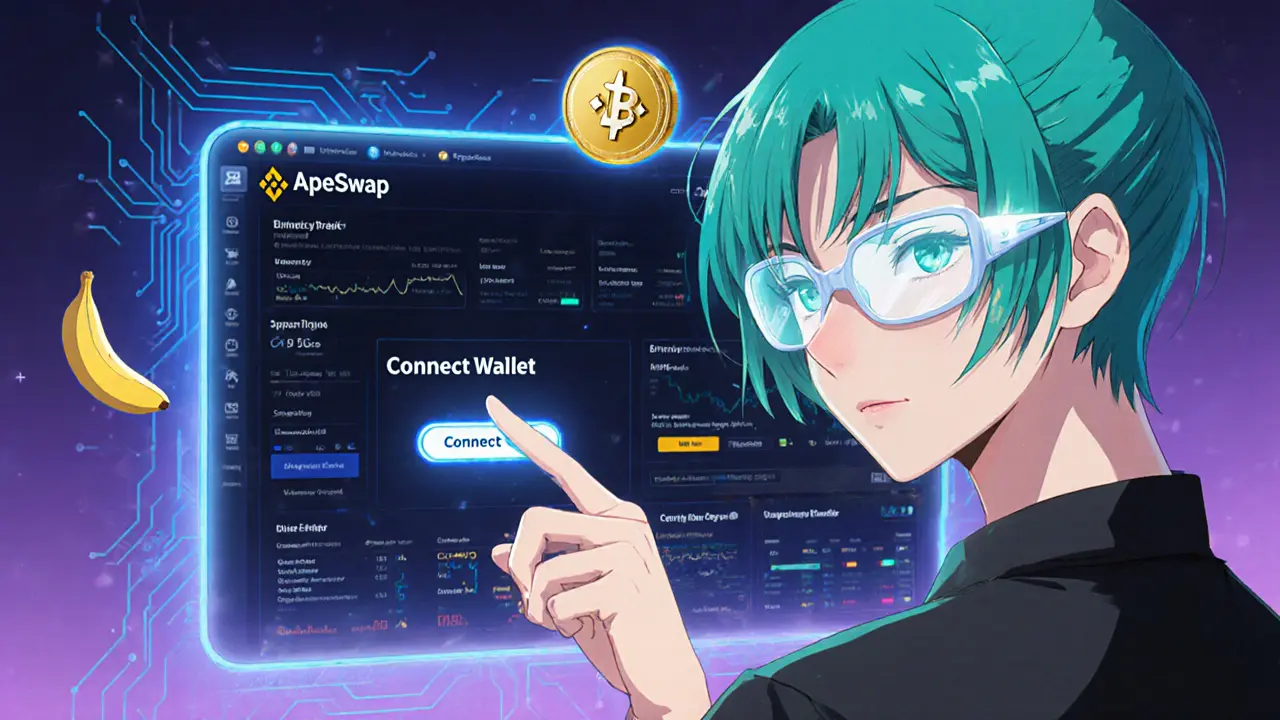ApeSwap Yield Farming Calculator
TL;DR
- ApeSwap is a BSC‑based DEX that mirrors PancakeSwap but adds multi‑chain support and specialized DeFi tools.
- Yield farming can reach 300‑400% APY on popular pairs like BNB/BUSD, while staking BANANA or GNANA offers up to 100% rewards.
- Security includes a Paladin audit and DAO governance, but lower liquidity can cause higher slippage.
- Great for intermediate DeFi users seeking high returns; beginners may find the learning curve steep.
When it comes to decentralized finance on Binance Smart Chain, ApeSwap is a fork of PancakeSwap that offers swapping, yield farming, staking, and lending across multiple blockchains. This ApeSwap review breaks down the platform’s core mechanics, tokenomics, security posture, and how it stacks up against the market leader.
What Is ApeSwap?
ApeSwap launched in 2020 on the Binance Smart Chain (BSC). Co‑founders Ape Guru and Obie Dobo built it as a community‑driven DEX, expanding later to Polygon, Ethereum, and Telos. The platform operates under a Decentralized Autonomous Organization (DAO), meaning token holders can vote on upgrades and fee structures.
Core Features
- Swapping: Instant token swaps with typical BSC fees (≈0.2% gas).
- Yield Farming: Over 100 liquidity pairs; high‑APY farms like BNB/BUSD offering 300‑400%.
- Staking: BANANA and GNANA can be locked for partner tokens.
- Lending Network: Borrow and lend assets directly from the platform.
- Treasury Bills: Convert LP tokens into discounted BANANA or partner tokens that vest over time.
All services are accessed through a Web3 wallet (MetaMask, Trust Wallet, etc.) - there is no custodial account, so users retain full control of private keys.
Tokenomics: BANANA & GNANA
The native utility token is BANANA. It powers governance, fee discounts, and rewards. Key attributes:
- Supply: 100billion tokens (inflationary model).
- Utility: Staking, fee rebates, DAO voting.
- Current price (Sep2025): ~ $0.000000015 (highly volatile).
GNANA is a governance‑focused token introduced in 2024 to separate voting power from liquidity incentives. Both tokens can be earned via farming or bought on major DEXes.
Security and Audits
ApeSwap underwent a security audit by Paladin in early 2023. The audit covered smart‑contract logic, re‑entrancy protections, and price‑oracle reliability. While no major exploits have been reported, the platform inherits typical BSC risks: potential rug pulls on low‑liquidity farms and reliance on a single chain for core swaps.
The DAO can freeze or upgrade contracts via community vote, adding a layer of on‑chain governance that many centralised exchanges lack.

Fees, Slippage, and Trading Experience
Because BSC processes blocks in ~3 seconds, transaction fees are minimal-usually less than $0.0005. However, the limited depth of some pools (especially newer ones) can cause slippage above 2% for sizeable trades.
The UI mirrors PancakeSwap’s layout, making navigation intuitive for experienced users. Newcomers might stumble on concepts like LP tokens, Treasury Bills, and multi‑chain bridges, so a brief tutorial is recommended before committing large capital.
Comparison: ApeSwap vs PancakeSwap
| Feature | ApeSwap | PancakeSwap |
|---|---|---|
| Launch Year | 2020 | 2020 |
| Primary Chain | Binance Smart Chain (multi‑chain support) | Binance Smart Chain |
| Liquidity Pairs | ~107 (incl. niche tokens) | ~300+ (wide range) |
| Average Daily Volume (2025) | $45M | $300M |
| Yield Farming APY | Up to 400% on select farms | Typically 20‑150% |
| Unique Tools | Treasury Bills, Lending Network | Lottery, NFT Marketplace |
| Governance Token | BANANA / GNANA | CAKE |
| Audit Provider | Paladin (2023) | Various (2022‑2024) |
In short, ApeSwap offers higher yields and niche DeFi products at the cost of lower liquidity and trading volume. PancakeSwap remains the go‑to for sheer market depth, while ApeSwap appeals to yield hunters and multi‑chain users.
Pros and Cons
- Pros
- High APY farms and staking rewards.
- Multi‑chain expansion (Polygon, Ethereum, Telos).
- DAO governance gives token holders a voice.
- Low gas fees thanks to BSC.
- Cons
- Lower overall liquidity leads to higher slippage.
- Complexity can overwhelm DeFi newbies.
- BANANA token price is extremely volatile with wildly divergent forecasts.
- Brand recognition still trails behind PancakeSwap.
User Experience & Community
Feedback from platforms like Bytwork and DappRadar shows a split sentiment. Experienced users praise the “up‑to‑100% staking” and “unique Treasury Bills,” while newcomers report a steep learning curve and occasional confusion over cross‑chain bridges. Community channels (Telegram, Discord) are active, and the DAO regularly polls token holders on proposals such as fee adjustments or new farm launches.
Future Outlook
As of September2025, ApeSwap’s roadmap includes deeper integration with Ethereum Layer‑2 solutions, additional lending pairs, and a revamped analytics dashboard. Analysts from DeFi Coin argue that the platform’s multi‑chain focus could capture users migrating away from congested Ethereum contracts, provided it scales liquidity. However, the long‑term success hinges on attracting more traders to boost daily volume and on maintaining transparent governance to avoid DAO stagnation.
Bottom Line
If you’ve already navigated BSC DEXes and are hunting higher yields, ApeSwap is a solid candidate. The platform’s innovative tools-Treasury Bills, lending, and GNANA governance-differentiate it from the PancakeSwap crowd. Just remember that high rewards come with higher risk: low liquidity, volatile BANANA pricing, and a learning curve that can trip up beginners.

Frequently Asked Questions
How do I connect my wallet to ApeSwap?
Click the “Connect Wallet” button on the homepage, choose a Web3‑compatible wallet (MetaMask, Trust Wallet, etc.), approve the connection in the wallet popup, and you’re ready to swap or farm.
What is the difference between BANANA and GNANA?
BANANA is the original utility token used for fee discounts, staking rewards, and basic governance. GNANA was launched later to separate pure governance power from liquidity incentives, allowing the community to vote on protocol upgrades without affecting reward calculations.
Are ApeSwap’s smart contracts safe?
The core contracts were audited by Paladin in 2023 and have not suffered major exploits since. However, as with any DeFi platform, users should only allocate capital they can afford to lose and consider using hardware wallets for extra security.
Can I use ApeSwap on Ethereum?
Yes. ApeSwap has deployed contracts on Ethereum (as well as Polygon and Telos). You’ll need to switch networks in your wallet and bear the higher gas fees typical of Ethereum.
What are Treasury Bills and how do they work?
Treasury Bills let you lock LP tokens for a set period (30‑90 days). In return you receive discounted BANANA or partner tokens that vest over the lock‑up term, effectively boosting your yield beyond standard farming rewards.







Comments
april harper
October 1, 2025 AT 02:18 AMThe promise of 300‑400% APY feels like a siren song for anyone chasing yield on BSC, yet the thin liquidity underneath those numbers can swallow optimism whole.
Kate Roberge
October 5, 2025 AT 04:18 AMHonestly, most folks treat ApeSwap like a glorified PancakeSwap clone, but the real issue isn't the fancy Treasury Bills-it's that the platform’s tokenomics are a roller‑coaster designed to pump BANANA at the expense of sustainable growth.
VICKIE MALBRUE
October 9, 2025 AT 06:18 AMLooks like a solid option for yield hunters.
Waynne Kilian
October 13, 2025 AT 08:18 AMWhile the APY figures are eye‑catching, we should also weigh the user experience; the UI mirrors PancakeSwap enough that newcomers aren’t forced to relearn everything from scratch.
Naomi Snelling
October 17, 2025 AT 10:18 AMThe security audit by Paladin in early 2023 gives a veneer of safety, but audits are snapshots, not guarantees.
On BSC, the risk of an exploit often lies in the peripheral contracts that handle bridge logic.
ApeSwap’s reliance on a single price oracle for many farms means a manipulated feed could inflate yields temporarily.
Moreover, the DAO’s ability to freeze contracts is only as strong as voter participation, which has historically been low.
Low voter turnout can let a small cabal push subtle changes that benefit insiders while the average farmer bears the loss.
Another hidden danger is the “Treasury Bills” mechanism, which locks LP tokens for days; if the underlying pool experiences impermanent loss, users may end up with less capital than they started.
The multi‑chain expansion sounds great, yet each added chain multiplies the attack surface, especially when bridges are still experimental.
Users also need to be mindful of the gas cost spikes on Ethereum; deploying the same strategy there can erode the headline APY dramatically.
The BANANA token’s inflationary supply, currently at 100 billion, dilutes holders unless the protocol can continuously generate new demand.
GNANA’s introduction was meant to separate governance from incentives, but it adds another layer of complexity that can confuse the community.
Slippage on low‑liquidity pools can exceed 2%, turning a theoretically 400% APY into a net loss after execution.
In practice, most yield farms on ApeSwap see a sharp drop in returns once the initial incentive period ends.
The platform’s community channels are active, yet the flood of hype can drown out sober analysis.
If you’re planning to allocate a significant portion of your portfolio, diversifying across multiple DEXes can mitigate the systemic risks inherent to any single ecosystem.
Bottom line: Enjoy the high returns, but keep a tight stop‑loss mindset and never invest more than you’re prepared to lose.
Michael Wilkinson
October 21, 2025 AT 12:18 PMDon’t be fooled by flashy banners; the real metric is net return after slippage and gas, and ApeSwap often falls short of its own promises.
Billy Krzemien
October 25, 2025 AT 14:18 PMExactly, if you calculate the effective APY factoring in typical 2% slippage on a 300% farm, you’re looking at roughly 280% before gas, which still beats many rivals.
Carl Robertson
October 29, 2025 AT 16:18 PMIt’s almost theatrical how ApeSwap flaunts “up to 400%” like a headline act, while the audience of average users is left scrambling backstage for decent liquidity.
Rajini N
November 2, 2025 AT 18:18 PMThat’s a fair point; the platform’s unique features such as lending and Treasury Bills do add depth, but they also require users to understand a broader set of risks that many ignore.
Oreoluwa Towoju
November 6, 2025 AT 20:18 PMApeSwap’s yield is attractive, but beginners should start small.
Jason Brittin
November 10, 2025 AT 22:18 PMSure, because nothing says “smart investing” like chasing 400% APY and then realizing you paid $15 in gas for a single trade 😂.
Amie Wilensky
November 15, 2025 AT 00:18 AMIn summary, ApeSwap offers high yields-but only if you tolerate the associated volatility!!!